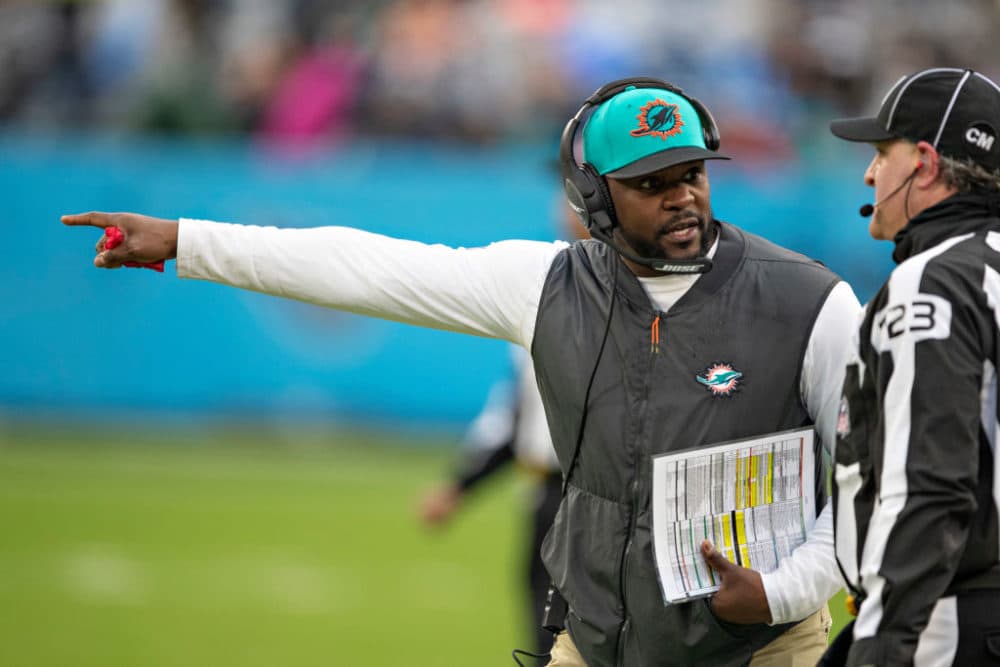Advertisement
Commentary
The NFL is a billion dollar 'plantation'

Last week, former Miami Dolphins coach Brian Flores filed a class action lawsuit against the National Football League that contained at least two explosive claims: that NFL owners engaged in sham interviews of minority candidates — a claim bolstered by text messages from none other than Bill Belichick — and that Dolphins owner Steven Ross had offered Flores cash to lose games on purpose, so the team could snag a top draft choice.
But the most remarkable aspect of the suit is that it says the quiet part out loud when it comes to the league’s inherent racial exploitation. “In certain critical ways,” the filing maintains:
the NFL is racially segregated and is managed much like a plantation. Its 32 owners — none of whom are Black — profit substantially from the labor of NFL players, 70% of whom are Black. The owners watch the games from atop NFL stadiums in their luxury boxes, while their majority-Black workforce put their bodies on the line every Sunday, taking vicious hits and suffering debilitating injuries to their bodies and their brains while the NFL and its owners reap billions of dollars.
This isn’t a legal claim so much as a factual description of the NFL’s racial and monetary dynamics.
If you want an even more egregious example, consider the league’s use of “race norming.” To understand how this works, it’s important to know that 4,500 former players sued the league a decade ago, seeking compensation for the neurological damage they suffered playing football. In settling the suit, the league’s own actuaries estimated that nearly a third of all NFL players will suffer some form of brain illness.
For those fans (or recovering fans, like me) who like to cart out the rationalization that NFL players know what they’re signing up for in terms of health risks, the whole point of the lawsuit is that the NFL spent decades denying those risks, or downplaying them by generating junk science.
It’s telling that the NFL settled out of court, rather than facing the public relations nightmare of former players and their loved ones testifying in public about the ravages of chronic traumatic encephalopathy (CTE), the brain disease that has afflicted dozens upon dozens of star players such as Junior Seau, who died by suicide at 43 years old.
But that settlement included the use of race norming, a practice in which the league assumed that African-American players had lower baseline cognitive abilities, and thus making it harder for them to receive the court-ordered payouts for the brain injuries incurred during their NFL careers.
So yeah: maybe the NFL is a little racist.
The league was, in turn, sued for this practice and announced they would discontinue its use. The date of this announcement? June 21, 2021.
To put this in perspective: the NFL is a league that makes billions of dollars every year by staging athletic contests in which predominantly Black players risk their brains for the profit of white owners, and the entertainment of mostly white viewers. When forced to compensate former players for their injuries, the league assumed that African-American players were inherently less intelligent than white players, and stiffed them many of them. It only stopped doing so a year ago, after being sued (again).
So yeah: maybe the NFL is a little racist.
Then again, the NFL is merely the showcase asset in a vast football industrial complex that reflects the systemic racism inherent in American society.
The sport is increasingly dominated by African-American players not because they are intrinsically more athletic — a myth perpetrated by sport journalists and fans alike — but because America provides fewer economic opportunities to poor boys of color.
The vast majority of NFL players are Black. Of its 32 teams, exactly one is led by an African-American.
In communities with underfunded schools and meager job prospects, football has become a hallowed pathway to success for those young men with a preternatural ability to run and jump and tackle. The message football sends to boys, of whatever race or class, is that they are valuable not for the content of their character but their physical prowess.
This is what the Flores lawsuit hints at: that the whole system by which young Black boys are harvested from America’s poorest neighborhoods, segregated from the general population, and exploited for their physical labors represents an extravagantly monetized plantation.
I have no idea whether Flores will be able to prove the central claim of his lawsuit: that the league’s owners are staging token interviews of minority candidates to satisfy a rule, rather than give such candidates a fair opportunity to become head coaches.
But as the nation prepares to celebrate Super Bowl Sunday next weekend, it’s worth letting the facts speak for themselves. The vast majority of NFL players are Black. Of its 32 teams, exactly one is led by an African-American.
